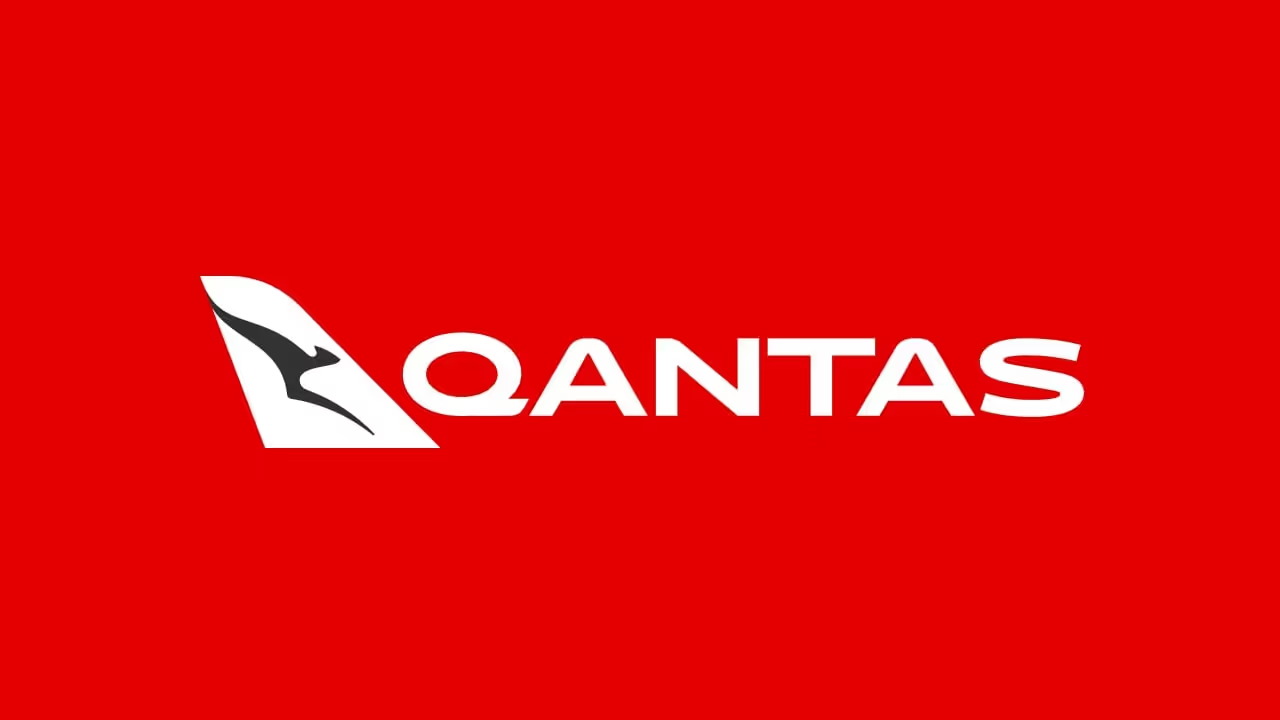The Qantas Group markets its brands - Qantas and Jetstar - mainly in the transport sector, offering regional, domestic, and international flights. From Qantas Freight to Qantas Frequent Flyer, the company has a broad portfolio of subsidiaries. Registered initially as Queensland Aerial Services Limited (QANTAS), its reputation is based on safety, operational reliability, engineering and maintenance, and customer service.
The company's history shows the importance of branding and how it can be used to transform from a local service provider to a globally recognized enterprise.
A few key facts about Qantas Group:
● Founded in the Queensland outback in 1920, Qantas is the world’s second-oldest airline (behind KLM).
● In response to COVID-19 pandemic, capacity was reduced by 94% as a result of the steep decline in passenger traffic in Q4 2020
● Qantas International operated more than 750 flights per week before March 2020.
● For its amazing record of firsts in operations and safety, Qantas ranked highest among 385 airlines, beating Qatar Airways, Air New Zealand, Singapore Airlines, and Emirates on the annual list of AirlineRatings.com.
Channeling military flight experience into a business
'The story of Qantas is the story of modern Australia,' the airline's chief executive Alan Joyce said succinctly. Like that of many other flagship airlines, the story began shortly after the First World War when aviation had already proved itself in the hands of the military. It was also logical that a continent of countries would need to connect its far-flung cities by air, as would the fifth continent with the outside world. The importance of the latter is not insignificant: in her anniversary address, Joyce recalls that the first plane once made 31 landings in 12 days from London to Australia and that the first non-stop passenger flights between Europe and Australia were recently made.
During World War I, Gallipoli veterans Paul McGinness and Hudson Fysh met while serving in Palestine with the Australian Flying Corps. A project for the first flight from Britain to Australia was completed by McGinness and Fysh, who carry out a land airfield survey between Longreach and Darwin. Thus, their idea of using military flying experience for civilian use was born.
In November 1920, the two war veterans registered a company, Queensland and Northern Territory Aerial Services Ltd, and drove around Darwin to find possible landing sites. In the first year, they started to introduce people to flying with walking flights and then began to expand the network, initially with Avro 504K biplanes.
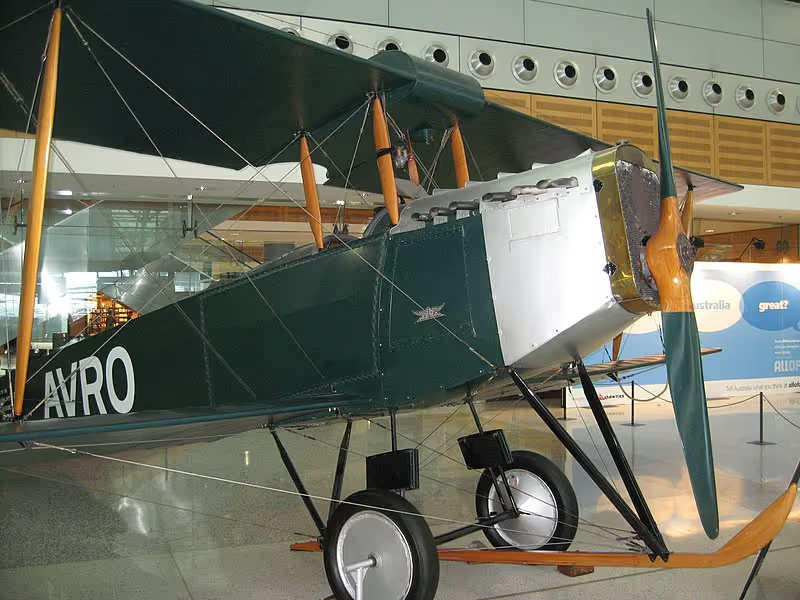
Western Queenslanders responded enthusiastically to Qantas' first air routes by purchasing shares and flying frequently using the airline’s services. The founders pioneered a new form of travel, which eventually became much more than an airline. NT in Qantas was their plan of flying overseas via Darwin, which was their primary entry point. A route network was soon developed from joyrides and charter services operated from western Queensland, Australia.
Joyrides: As the name implies, joy ride flights are for pure entertainment. While back in the early 20th century, airplane capabilities were limited compared to today's highly maneuverable aircraft. The scenic views and aerobatics were enjoyed by many at the time.
In 1922 Qantas was already operating with passengers and as a mail distribution service. In 1924 the Australian Prime Minister flew with the airline because a storm had damaged the Winton-Longreach road. To further developed its revenue streams, Qantas operated the first Flying Doctor air ambulance service. The original Qantas became one of the few airlines to build its own aircraft (DH50) in 1926.

DH50, the first Qantas-manufactured aircraft
De Havilland Aircraft Company built this large biplane at Stag Lane, Edgware, in the early 1920s, one of the company's first successful designs. At the rear of the aircraft, the pilot sat in an open cockpit, while three passengers sat in an enclosed cabin in the center of the fuselage. It won praise for its handling characteristics as well as its performance. Passengers and pilots alike loved it.
A slightly enlarged cabin, a larger radiator area, as well as other modifications made to the De Havilland DH50A, marked its first production version. The National Airline QANTAS acquired a production license for the type following the delivery of nine DH50As to Australia. De Havilland modified a British-built Qantas DH50 in Queensland to fulfill the requirements of the Australian Inland Mission and became an aircraft used by the Royal Flying Doctor Service of Australia. A total of 38 planes have been manufactured over the years of this type.
Key Takeaway #1: Building on years of experience
The founders of Qantas built their initial services on years of experience gained in the military. Even the flight zone was the same one they already knew! The duo started small but had the vision to pioneer civil aviation and slowly built their company.
An important lesson from the Qantas story is to leverage your hard-earned experience, market knowledge, and the tools you have access to. Many startup founders make the mistake of venturing into completely new market areas that they have no idea about, rather than using the professional experience they already have.
During and after the Second World War
Qantas Empire Airways went abroad in 1935 and flew the first service between Brisbane and Singapore with DH-86. Later, in the golden age of seaplanes, the company began service between Sydney and Singapore. The prestigious short type, the Empire, with its comfortable main deck and high passenger comfort, was used on this route.
Qantas, mainly based on the founders’ military experience was heavily involved in different scenarios during the Second World War:
● After the declaration of war in 1939, Qantas continued to operate in Singapore and within Australia, despite some aircraft being transferred to the Royal Australian Air Force.
● During the second east-west air crossing of the Pacific Ocean, 19 Catalina flying boats were brought from the United States to Australia by Qantas crews in 1941.
● When Japanese forces occupied most of Southeast Asia in February 1942, Singapore's operations ended.
● The Dutch East Indies were evacuated to Australia via Qantas flying boats.
● Japanese aircraft shot down two Qantas Empire flying boats in early 1942.
● The Qantas hangar and flying boat maintenance facilities were destroyed in the first Japanese air raid on Darwin on 19 February 1942. A flying boat from the Qantas fleet narrowly escapes destruction.
● From Mount Hagen in New Guinea, 78 people were evacuated by a Qantas DH86 aircraft in May 1942.
The first steps in building the company brand
During the Second World War, only a few air routes were left - one of them was Qantas maintaining a link between Perth and Ceylon using Catalina seaplanes. Catalina flying boats covered 5,600 kilometers nonstop in 28 to 33 hours of nonstop flight. The passengers were presented with membership certificates from the "Rare and Secret Order of the Double Sunrise."

"Sublime Order of the Longest Jump" was awarded to passengers of Liberator aircraft in 1945. After the war, the Liberators were the first to carry the Kangaroo silhouette, followed by DC-3s, and 4s flying mainly internal routes. Qantas maintained its military charter flight capacity to Japan in the Korean War to create a revenue stream.
The peak of the radial engine era was the beautiful Lockheed Constellation, which also opened the Kangaroo Line between London and Sydney. At that time, the route network included Hong Kong and Tokyo, and Beirut and Frankfurt in 1952.

Key Takeaway #2: Brand development
The history of Qantas tells us that even in the most desperate of times, during World War II, the company worked doggedly to build a brand and maintain maximum service levels. After the Japanese bombed Qantas' infrastructure system, the company could have closed its doors, but instead, it carried on and maintained some civilian lines. These aircraft featured the company's logo, the iconic kangaroo, and helped build the company's image as a reliable, professional, and safe organization.
Today, there is almost no market where you will not encounter some type of competition. There are national and global, smaller and more agile, and larger, corporate-like players targeting the same audience as your company. You need to stand out somehow, and the best way to do that is to build a brand with characteristics that your audience can identify with.
The age of aviation
The Jet Age
Throughout the history of aviation, the Jet Age was defined by the advent of aircraft powered by turbine engines and the resulting changes in society.
Due to the jets' ability to fly longer and faster than older piston-powered propliners. Leaving Australia and flying across the Pacific and Indian Oceans, aircraft were able to travel non-stop to their destinations, making it possible to travel to long-distance destinations within a single day. In addition to carrying more passengers than piston-engined airliners, large jetliners also lower airfares, so people from a broader socioeconomic range could travel across borders.
Qantas was among the pioneers in operating a lower-cost Tourist Class on various routes to bring the experience of flying to new audiences.
In addition to the advantages of the jet stream, the turbine-powered engines provided a smoother ride and better fuel economy compared to their predecessors. Among the exceptions to the jet-powered dominance of large airliners was the contra-rotating propeller turboprop design that powered the Tu-114 (first flight 1957). Although this airliner was able to match or even exceed the speed, range, and capacity of contemporary jets, its use in large aircraft was restricted to the military after 1976.
Qantas is recognized internationally for its engineering quality and safety record. First to offer a business class in 1979, and the first to introduce the slide raft in 1982, which has been a standard feature on all large commercial planes ever since.
The Boeing - Qantas partnership
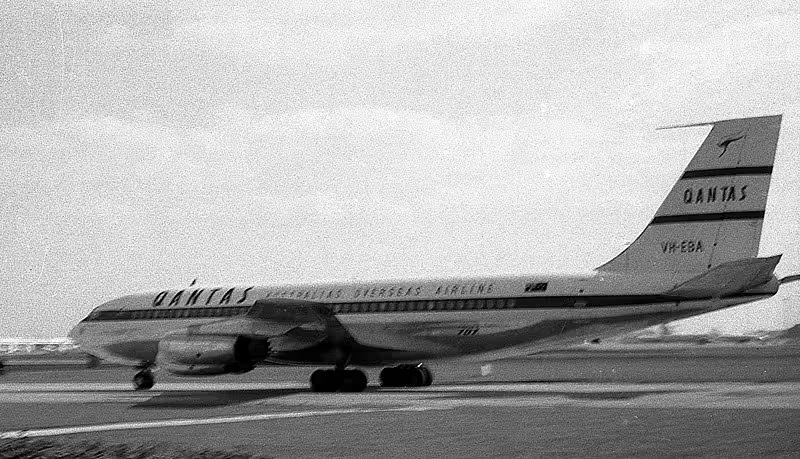
With the Boeing 707 in 1959 and later the 747 in 1966, the jet age halved flight times. During the 1960s, Qantas entered the jet age when it began flying Boeing 707s from London. The result was a marked improvement in journey times and an expansion of its global network. Two days after its inaugural flight from Sydney to San Francisco, the first flight departed London on 31 July 1959.
By flying from London to Sydney via San Francisco, passengers can save over 25 hours on their journey. In 1961, Boeing introduced a special version of the 707 known as the "V Jet". Equipped with significantly powerful engines, the V jet continued to enhance the experience of the London to Sydney line.
During this time, Qantas ordered airplanes from Boeing to serve on other routes, such as:
● Hongkong
● Singapore
● The short-lived Fiesta Route - from the UK to Australia via Bermuda, Nassau, Mexico City, Acapulco, Tahiti, and Fiji
Boeing’s jet engine airplanes empowered Qantas to become a truly global airline offering its flight services to all popular countries of Europe, the Americas, and the APAC region.
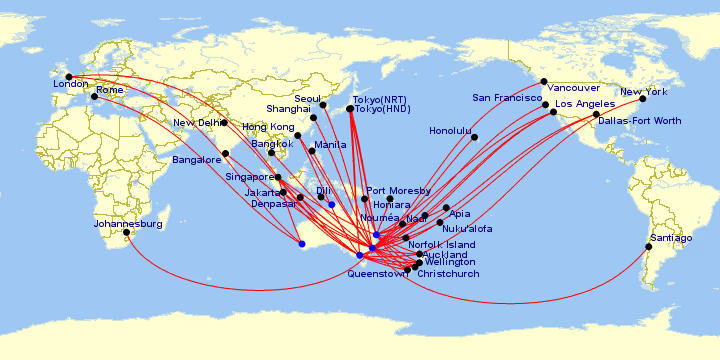
Stewards and stewardesses
In Qantas' case, flight hostesses, in particular, became one of the airline's most visible, glamorous marketing symbols. But it wasn’t how it started.
The wife of Qantas' founder, Hudson Fysh, was entrusted with the task of hiring the airline's first intake of hostesses. Patricia Burke was among nine "girls" selected by Mrs Fysh and her team from a field of 1,000 applicants from all over Australia.
They performed clerical duties on board and assisted stewards in serving meals to passengers. The captain personally directed them. As Patricia recalled in an interview with the Sydney Morning Herald: "We were trained very well in safety and loading procedures, shown how to serve passengers properly and we were taken on a familiarisation flight to Singapore in a seaplane. We didn't have to push heavy trolleys of food and drink up the aisles: that was left to the stewards but we did assist them to serve it. I was paid ten pounds a week but the stewards got more and tips as well. Hostesses were never tipped. It was not ladylike."
While the Flight Stewards Association of Australia represented the majority male workforce, as of 1957, the Aviation Hostesses Association was formed to represent local and international flight hostesses. With almost only female members and strong collective bargaining, the AHA was unique at that time.
The Airline Hostesses Association also played a significant role in supporting the Qantas Flight Hostesses' strike for career advancement and equal pay. The Hostesses of past eras were required to ‘retire’ at the age of 35 without having the option of applying for promotions such as Senior Flight Steward, Chief Steward, or Flight Service Director.
After decades of competition, the two representative organizations joined forces in 1992 and became one under the name Flight Attendants Association of Australia.
Key Takeaway #3: Pushing the limits of innovation
Throughout its more than 100-year history, Qantas has been at the forefront of innovation. Of course, one of the main drivers has been the long distance to other countries, which has led the company to look for cheaper solutions. Thanks to its partnership with Boeing, Qantas was one of the first airlines to offer non-stop flights and also invested heavily in research and development to improve safety.
Although being far from the most popular destinations seems to be a significant disadvantage compared to traditional European and American airlines, Qantas turned this into a growth engine.
An alliance and privatization
Founding the OneWorld Alliance
Alliances between airlines are now an integral part of travel. Star Alliance, SkyTeam, and OneWorld are three of the major airline alliances. For the airlines, there are benefits in terms of cost savings and operational efficiencies; for passengers, there are facilitations in routing and connections; and, of course, there are loyalty benefits for all airlines.
It hasn't always been like this. Pan American World Airways and Panair de Brasil operated routes to Latin America together as early as the 1930s. In the early 1990s, there were also several African airlines offering services in an alliance. However, it was not until the late 1990s that a truly global alliance began to emerge.
Oneworld was co-founded in 1998 by Qantas, British Airways, Cathay Pacific, and American Airlines. With Iberia Airlines and Finnair joining in the same year, the alliance became operational in February 1999.
Oneworld targets the premium travel market and allows passengers to enjoy a wider route network than would be possible on their own. Airlines work together to keep costs down and achieve operational synergies. In 1998, the alliance carried 181 million passengers annually (to 648 destinations in 139 countries).
As part of the alliance's launch, all industry personnel were involved in extensive communication and training programs. In addition, the slogan "Oneworld revolves around you" was used for a major advertising campaign.
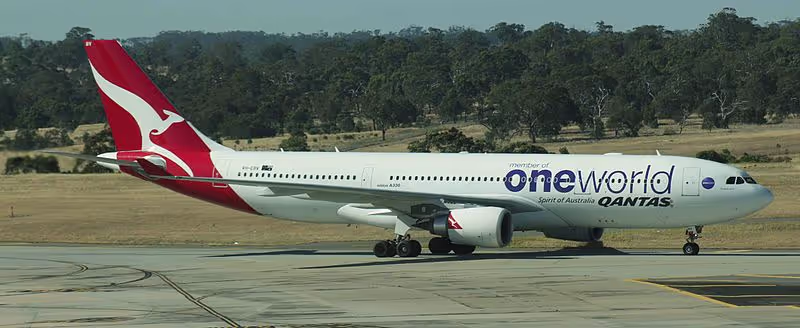
Today, under the OneWorld alliance logo, 14 world-class airlines offer seamless service and connections to more than 1,000 destinations in nearly 170 countries and territories. Member airlines work together to ensure the perfect flying experience - from check-in to boarding. OneWorld also plans to open its own branded airport lounges at major hub airports. Recently, the alliance introduced a new form of membership. Thanks to OneWorld Connect, regional airlines can take advantage of the alliance's benefits. Fiji Airways is the first airline to join this program.
In addition to consumer services, OneWorld Alliance provides services for corporate clients. According to the Alliance’s website, companies enjoy the following benefits:
● With global coverage, OneWorld flies to and from the world's most important markets and has global support centers in those locales.
● There is flexibility with flights, fares, and product options. First Class, Business Class, and Premium Economy come with award-winning fully flat seats.
● The Global Corporate Program gives each member a single, dedicated OneWorld contact, which streamlines communication and contractual implementation.
● Single legal agreement and four-year commitment: Streamlined sign-up that only takes a couple of minutes. All OneWorld airlines share the same expiration dates.
● Corporate clients get perks that give frequent flyers an edge, such as lounge access to top-tier cards, priority check-in, pre-boarding, and preferred seating options.
The privatization process of Qantas
Qantas was first given access to the national domestic market as a result of the Government of Australia's 1992 sale of Australian Airlines. As part of the purchase, the company added the Boeing 737 and Airbus A300 to its fleet, although the latter airplane type was eventually retired.
In March 1993, Qantas was privatized, with British Airways purchasing 25% of its shares for A$665 million. Profits increased by nearly 80% over the first half of 1995, allowing the Australian Government to sell its remaining 75% stake. Across the six months through the end of December, the company reported a net profit of A$129 million ($95 million), while sales was increased by 9.5%.
A 2% increase in yields across the network boosted performance. Despite a 10% increase in capacity, Qantas claimed that it had avoided diluting its load factors. Although earlier concerns about intense competition from privately held Ansett had arisen, the airline’s domestic operations have improved significantly. Operating profit for the domestic sector was $A51 million, as revenues grew by 24%.
During that time, Qantas highlighted that it started to see benefits from its alliance with British Airways, such as joint marketing and purchasing. In the wake of British Airways' purchase of 25% of Qantas, the remaining shares have been sold progressively later as the business has been reorganized and the top management has changed.
Qantas decided to proceed with the rest of its float in 1995. Public share offers were conducted in June and July of that year, earning the government A$1.45 billion. The remaining shares were sold in two phases in 1995–96 and 1996–97.

The stock float attracted significant interest from investors outside Australia, who bought 20 percent, while British Airways purchased 25 percent. This meant Qantas became 55% Australian-owned and 45% foreign-owned once listed on the stock exchange. By law, at least 51% of the company must be owned by Australians, so foreign ownership is constantly monitored. However, the tense situation changed when British Airways sold its 18.5% stake in Qantas in September 2004 for £425 million, though keeping its close ties with the Australian carrier intact.
Key Takeaway #4: Offering services with your competitors
Of course, Qantas did not enter into an alliance with its closest competitors but saw the opportunity to join forces with similar airlines covering long distances. The ultimate goal was to create a network that would reach all parts of the world and generate contacts with members through consumer and corporate agreements. Under a single brand umbrella, member companies provide services that they could not provide without each other, resulting in an increase in revenue.
The present and future of Qantas
Airplanes, the most important assets of any airline
The most vital asset of any airline is its fleet. Qantas has been a pioneer in implementing new technologies and integrating the newest airplane types into its fleet for more than 100 years. Let's take a look at Qantas' current aircraft!
In contrast to 1970, when the company had 28 airplanes (mainly Boeing 707s), Qantas and its subsidiaries operated 297 aircraft as of November 2018. Qantas subsidiaries operate the majority: Jetstar Airways aircraft made up 71 of the fleet, 90 were operated by various QantasLink airlines, and six by Express Freighters Australia. Over the years, Qantas has always favored Boeing aircraft over products from other suppliers, but the other major civil aircraft manufacturer, Airbus, is also represented in the fleet.
Airbus A320
The Airbus A320 is a twin-engine, single-aisle, narrow-body, medium-range passenger aircraft developed by Airbus in the late 1980s, primarily to compete with the Boeing 737 and its various successors, the McDonnell Douglas DC-9. Digital electronic steering was used for the first time on a passenger aircraft. To date, over 4,400 aircraft have been delivered, making it the second-largest passenger aircraft ever built.
Airbus A330

The Airbus A330 is a wide-body, high-capacity passenger aircraft for medium- and long-haul flights made by the European airline Airbus, competing mainly with the Boeing 777. It was developed in the 1990s in parallel with the Airbus A340, which is why the two aircraft share many systems: They have the same wings (two engines on the A330 and four on the A340), the same fuselage structure, and the same avionics.
The main motivation for the development was the airlines' desire to use a twin-engine aircraft for certain long-haul routes, which was not much smaller than the three- and four-engine aircraft used until then. Twin-engine aircraft did not exist for ocean-going flights. It was not until the 1980s that engines were developed that were reliable enough to meet the safety requirements on transcontinental routes.
Airbus A380
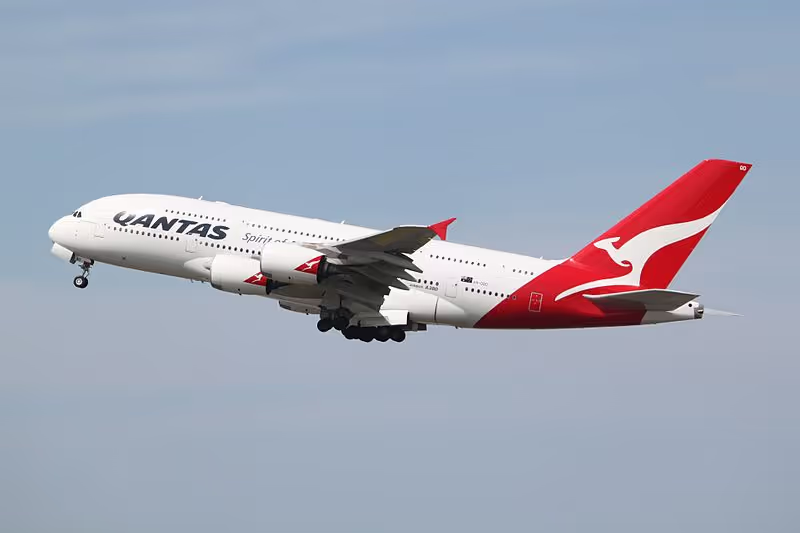
The Airbus A380 is a twin-engine, four-engine wide-body passenger aircraft manufactured by the European company Airbus. The A380 is currently the largest passenger aircraft in the world. It first took off from Toulouse, France on April 27, 2005, and made its first scheduled flight on October 25, 2007, between Singapore and Sydney on behalf of Singapore Airlines. Its size quickly earned it the nickname "Superjumbo".
Boeing 717
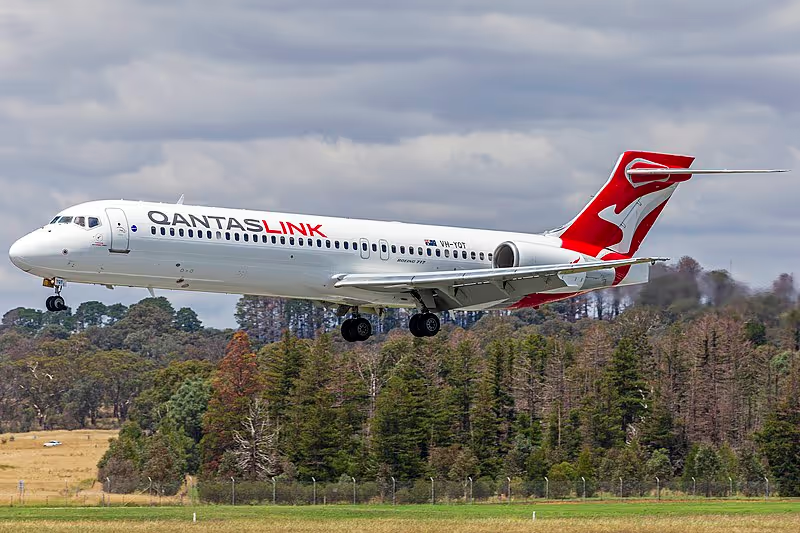
The Boeing 717 is a narrow-body twin-engine aircraft developed by McDonnell Douglas under the designation MD -95 as a successor to the third-generation DC-9. The first Boeing 717 entered service in 1999, and production of the series was completed in 2006. The aircraft has a maximum capacity of 117 passengers, a range of 3,820 km, and is powered by two Rolls-Royce gas turbine engines.
Boeing 737
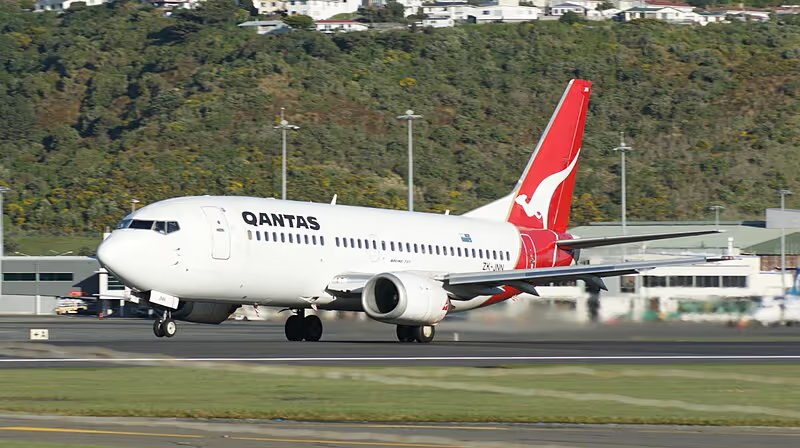
The Boeing 737 is the world's most popular medium-range narrow-body aircraft. By December 2011, it had more than 7,000 orders (6,000 were delivered in April 2009). By November 2019, it was the most ordered and most produced commercial airliner ever, with 15,156 orders and 10,565 deliveries.
Boeing announced the B737 on February 19, 1965, a twin-engine jet-powered turboprop aircraft for short-haul routes to complete the family of passenger aircraft. The 800, which Qantas also used, could carry 160 passengers in a typical two-class configuration and 184 in a single-class configuration.
B787-9 Dreamliner
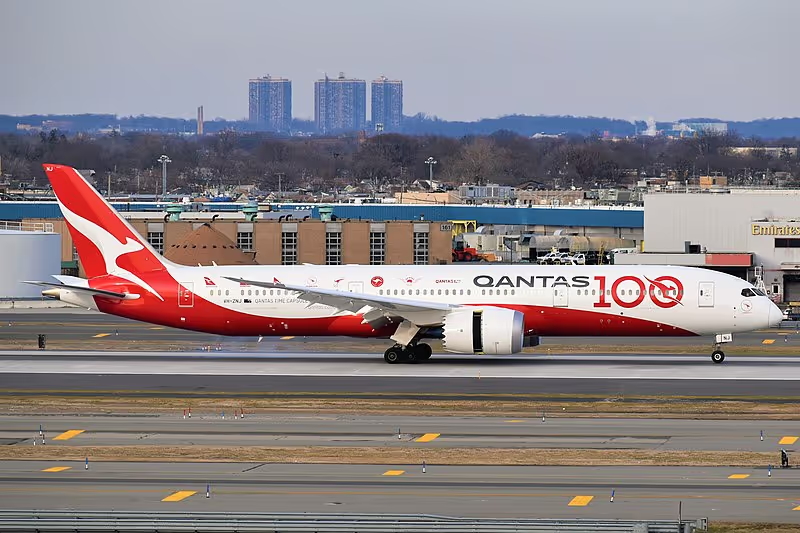
The Boeing 787 Dreamliner (development designation 7E7 or Y2) is Boeing Commercial Airplanes' latest twin-engine, long-range, mid-size, wide-body aircraft designed and manufactured in the United States. Its various versions can accommodate 242to 335 passengers in three classes. It is the first passenger aircraft to have a large portion of its fuselage made of composite materials. It is designed to consume 20% less fuel than the Boeing 767.
The main focus in the development of the 787 was to reduce the weight of the aircraft. The aircraft is made of 80% composite materials. In the 787's onboard systems, the most striking feature is the new efficient electronic architecture, which replaces the previous compressed air and hydraulic components with electric compressors and pumps and eliminates pneumatics and hydraulics in some subsystems (e.g. engine starters or brakes). Another new feature of the 787 is the electronic wing heating system, which heats the wing surface electrothermally, replacing the previous hot air heating system.
En route around the world - Qantas’ currently available flights

Subsidiaries
The company is also engaged in a broad range of subsidiaries and related businesses, including holiday and travel operations, in addition to the business of transporting passengers and cargo.
● QantasLink: A network of 56 metropolitan and regional destinations across Australia are served by it on over 2000 flights each week.
● Qantas Loyalty: Through its Qantas Frequent Flyer and Qantas Business Rewards programs, Qantas Loyalty is an innovative data-driven business that drives customer and partner loyalty.
● Qantas Freight: Every day, Qantas Freight flies more than 4,000 air freight items to more than 500 destinations around the world.
● Jetstar: Is a low-cost airline network with destinations within Australia, and also New Zealand (both completely operated by Qantas Group), and multiple co-operated companies, including Jetstar Asia, Jetstar Pacific, and Jetstar Japan.
● Jetconnect: Is a New Zealand-based subsidiary of the Qantas Group that offers trans-Tasman services. The company also provides cabin crew to Qantas for flights to Australia and around the world.
Qantas and COVID-19
A 3-year plan was outlined in June 2020 to guide Qantas Airlines through the COVID-19 crisis.
The recovery plan focused on three immediate actions:
● Reinforce the financial resilience of the company through a $1.4 billion equity raise.
● With the ability to scale up as demand grows, the proper workforce size, fleet size, and other costs should be considered.
● Streamline all operations to reduce costs and improve efficiencies.
The grounding of some 200 Qantas and Jetstar aircraft means the loss of at least 6,000 jobs and extended stand-downs for thousands of employees.
Key Takeaway #5: How to cope with crisis
The history of Qantas teaches us that the more successful a company is and the longer it has been operating, the more crises it has to deal with. COVID-19 hit all airlines around the world hard, forcing them to cease operations completely. Qantas was also forced to cease operations, but it has created a plan that reflects the present and considers the future.
Marketing above the clouds
How Qantas’ logo changed over time
During more than 100 years of operation, between 1920 and today, Qantas’ logo and name were changed several times.

The brand today
Qantas strives to emphasize reliability, safety, quality customer service, operational efficiency, and innovation as part of all its marketing efforts. Globally, the brand is strong and represents Australian culture. As the slogan says, "The spirit of Australia" captures exactly what the company’s brand is about.
Pricing strategy
In its pricing strategy, Qantas can utilize its diverse portfolio of subsidiaries, and offer wide price ranges for a vast amount of destinations. Most of Qantas' passengers are frequent business travelers. Qantas charges a premium price for its flights because of the aircraft's comfort and contemporary entertainment facilities. Its marketing mix has a premium pricing strategy that incorporates cost, benefits, and quality service value additions. In offering 'refunds', Qantas develops trust and loyalty in its target market.
Qantas advertisements
To market itself, Qantas uses several media channels such as TV, print, and online. The Qantas frequent flyer program is regarded as one of the best loyalty options because it offers a wide range of facilities to Qantas' frequent flyers and maintains the balance between retaining and acquiring customers.
Through its Aboriginal and Torres Strait islander initiative, Qantas promotes the arts and culture of Australia, showcasing its 'spirit of Australia'. Qantas has developed into a premium brand around the world for its sophisticated, hi-tech facilities and safe production standards. Qantas services and touring options are trusted by millions, who remain loyal to their brand name. One of Australia's national sports is rugby, which is sponsored by Qantas and helps with brand recognition.
The LGBTQIA community is openly supported in its campaigns, which earned the organization a positive image. These activities are aimed at developing a brand personality that the customers can relate to, especially since they are geared toward well-qualified and open-minded customers.
Most notable Qantas advertisements:
● I hate Qantas: From 1962- 1992, Qantas advertised with a gruff koala who lived by the slogan "I Hate Qantas".
● The Flying Kangaroo: In the 80s, no great advertisement worked without a theme song.
● Standing up: A recent commercial with actor Hugh Jackman, who became a Qantas Ambassador.
Key Takeaway #6: Pricing with a strategy in mind
Qantas has always strived to offer a diversified service portfolio complemented by a diverse pricing strategy to ensure maximum profit. The service provider uses subsidiaries to offer low-cost flights for shorter routes, while Qantas' mainline services have been created with a luxury image in mind to enable higher fares.
Final thoughts and key takeaways of Qantas Group’s story
Growth by numbers
Key takeaways from Qantas' story
● Building on years of experience: Stories like AirBnB's are hard to follow - most successful founders leverage their existing experience and market knowledge rather than venturing into uncharted territory. The founders of Qantas used their experience gained as military pilots to launch a new airline in Australia.
● The importance of brand development: A company can only sell products and services if customers resonate with its brand. Quality, safety, and professionalism have been part of the Qantas brand for more than 100 years. The team at Qantas did not even stop building the brand when the company was forced to participate in World War II.
● Pushing the limits of innovation: Qantas pioneered aviation technology and safety. The company always spent a significant portion of its budget on manufacturing, innovation, and R&D activities.
● Offering services with your competitors: The Australian company partnered with similar companies around the world to offer complementary services and gain access to new markets and customers. Use partnerships to develop business and increase profits.
● How to cope with a crisis: Qantas created a plan that ensured the integrity of the company and prepared it for future expansion. One of the key takeaways from this story is that you should always prepare for the future while dealing with current challenges.
● Pricing with a strategy in mind: Qantas is a master at using different pricing strategies that complement each other. Embrace the Qantas mindset in your market and consider how you can offer different packages and how you can target customers that you can do more business.
Throughout more than 100 years, Qantas Group has made an extraordinary journey that holds many takeaways for present entrepreneurs. Although the company is not at its peak due to the global pandemic situation, the team already has plans on how to ensure the future growth of the airline group. Alan Joyce, CEO of Qantas, is already eyeing the newest aircraft types from both industry-leading manufacturers that will ensure a quicker-than-ever connection between Australia and even the most distant places on the globe.


